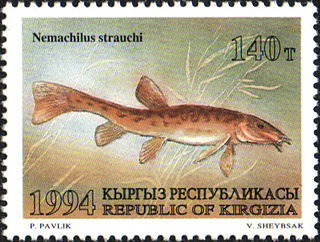Triplophysa gejiuensis is a species of stone loach endemic to China. It is a blind, subterranean fish found in underground river in Gejiu, Yunnan.

Triplophysa is a genus of fish in the family Nemacheilidae found mainly in and around the Qinghai-Tibet Plateau in China. Currently, the genus is a mixed assemblage of species. Some lineages have been identified and treated as subgenera, but as Wikipedia follows Fishbase for fish species all but Hedinichthys have been treated as subgenera in Wikipedia, although Kottelat in his revision of the loaches did recognise them as valid. FishBase, however, includes these in Triplophysa without specifying subgenera and treats the names given by Kottelat as synonyms.
Triplophysa xiangxiensis is a species of stone loach endemic to Yuan River in Hunan, China. It is a cave-dwelling species. It grows to 9.9 cm (3.9 in) SL.
Triplophysa coniptera is a species of stone loach in the genus Triplophysa. It occurs in the Talas River basin, Kyrgyzstan, and the middle Syr Darya basin, Uzbekistan. The latter population may qualify as the subspecies salari.
Triplophysa dalaica is a species of stone loach. It is only known from Hulun Lake in Inner Mongolia, China; it is believed to occur more widely as fish in this genus typically occur in running water.
Triplophysa dorsalis, the Grey Stone Loach, is a species of stone loach in the genus Triplophysa that lives in freshwater. It is found in Uzbekistan, Kazakhstan, Kyrgyzstan and Xinjiang.
Triplophysa herzensteini is a species of ray-finned fish in the genus Triplophysa , it is placed in the subgenus Labiatophysa which is regarded by some authorities a valid genus.

Triplophysa intermedia is a species of ray-finned fish in the genus Triplophysa. The species has only been found in Hulun Lake in Inner Mongolia, China; but is believed to appear in other locations as well since fish in this genus are typically found in running water.
Triplophysa marmorata, the Kashmir Triplophysa-loach, is a species of ray-finned fish found in Asia. It's a scaleless inland fish that is endemic of wetlands like the Wular Lake in Jammu and Kashmir, India. Like similar species T. kashmirensis, it presents a slender caudal peduncle, but it's shorter in the case of T. marmorata. Its specimens can also be differentiated because of their shorter lateral line length. Their diet is composed of detritus, plants that coat rocks and stones, and the associated invertebrate fauna. They reach maturity after two years.
Triplophysa microps is a species of ray-finned fish in the genus Triplophysa. It is found in shallow streams at the upper reaches of the Yellow, Yangtze, Salween, Mekong, Indus and Brahmaputra Rivers and also in alpine lakes in the Tibetan plateau.
Triplophysa moquensis is a species of ray-finned fish in the genus Triplophysa. It is endemic to Xiaman Lake, Sichuan, although it might occur more widely.
Triplophysa obtusirostra is a species of ray-finned fish in the genus Triplophysa. It is endemic to Qinghai province, China, near the origin of the Yellow River.
Triplophysa orientalis is a species of stone loach. It is a freshwater fish from the Tibetan Plateau and is endemic to China; its distribution includes the upper reaches of the Yangtze and Yellow Rivers, among others. It lives in a wide range of habitats, both lentic and lotic. The species is widespread but populations tend to be isolated and show high degree of genetic divergence.
Triplophysa stenura is a species of ray-finned fish in the genus Triplophysa. It lives in swift-flowing streams and is known from the Upper Yangtze, Upper Mekong, Upper Salween and Upper Brahmaputra river drainages in China and Vietnam. Whether this apparently widespread species really is one species needs to be studied. It grows to 13.8 cm (5.4 in) SL.
Triplophysa stewarti is a species of stone loach in the genus Triplophysa. It lives in slow-flowing rivers and lakes among rocks and vegetation; it is found in numerous lakes and in upper Salween, Indus, and Brahmaputra drainages in Tibet as well as in Kashmir, India. It grows to 20.8 cm (8.2 in) SL.

The Tibetan stone loach is a species of ray-finned fish in the family Nemacheilidae. The specific name is sometimes spelled stoliczkae but the original spelling used by Steindachner is stoličkai. It is found in southern and central Asia.
Triplophysa tibetana is a species of stone loach in the genus Triplophysa. It is endemic to the upper Brahmaputra and upper Indus rivers in Tibet. It lives in slower flowing, shallow areas in lakes and rivers with ample aquatic vegetation. It grows to 13.3 cm (5.2 in) SL.
Triplophysa turpanensis is a species of stone loach in the genus Triplophysa. It is endemic to Xinjiang in extreme western China. It grows to 7.7 cm (3.0 in) SL.
Triplophysa xichangensis is a species of ray-finned fish in the genus Triplophysa. It is found in Sichuan and Yunnan provinces in China.

Triplophysa strauchii, the Spotted thicklip loach, is a species of ray-finned fish in the genus Triplophysa. It is widespread in the basins of Balkhash, Issyk-Kul, Sassyk-Kul and Ala-Kul, and basins of Lake Zaysan, in Tarim basin. It can grow up to 25 cm (9.8 in) in length.




